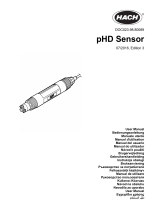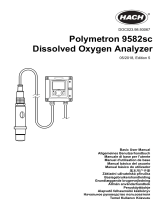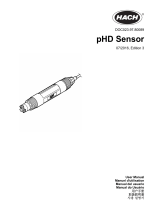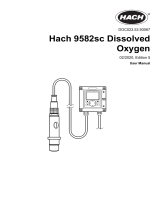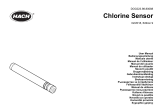Page is loading ...

Model 1054B CL
Free Residual Chlorine Microprocessor Analyzer
Instruction Manual
PN 51-1054BCL/rev.B
April 2003

WARNING
ELECTRICAL SHOCK HAZARD
Making cable connections to and servicing this
instrument require access to shock hazard level
voltages which can cause death or serious injury.
Be sure to disconnect all hazardous voltage
before opening the enclosure.
Relay contacts made to separate power sources
must be disconnected before servicing.
Electrical installation must be in accordance
with the National Electrical Code (ANSI/NFPA-
70) and/or any other applicable national or local
codes.
Unused cable conduit entries must be securely
sealed by non-flammable closures to provide
enclosure integrity in compliance with personal
safety and environmental protection require-
ments.
The unused conduit openings need to be sealed
with NEMA 4X or IP65 conduit plugs to maintain
the ingress protection rating (IP65).
For safety and proper performance this instru-
ment must be connected to a properly ground-
ed three-wire power source.
Proper relay use and configuration is the
responsibility of the user.
No external connection to the instrument of
more than 69VDC or 43V peak allowed with the
exception of power and relay terminals. Any vio-
lation will impair the safety protection provided
Do not operate this instrument without front
cover secured. Refer installation, operation and
servicing to qualified personnel..
ESSENTIAL INSTRUCTIONS
READ THIS PAGE BEFORE PRO-
CEEDING!
Rosemount Analytical designs, manufactures, and tests its
products to meet many national and international stan-
dards. Because these instruments are sophisticated tech-
nical products, you must properly install, use, and maintain
them to ensure they continue to operate within their normal
specifications. The following instructions must be adhered
to and integrated into your safety program when installing,
using, and maintaining Rosemount Analytical products.
Failure to follow the proper instructions may cause any one
of the following situations to occur: Loss of life; personal
injury; property damage; damage to this instrument; and
warranty invalidation.
• Read all instructions prior to installing, operating, and
servicing the product. If this Instruction Manual is not the
correct manual, telephone 1-949-757-8500 and the
requested manual will be provided. Save this Instruction
Manual for future reference.
• If you do not understand any of the instructions, contact
your Rosemount representative for clarification.
• Follow all warnings, cautions, and instructions marked
on and supplied with the product.
• Inform and educate your personnel in the proper instal-
lation, operation, and maintenance of the product.
• Install your equipment as specified in the Installation
Instructions of the appropriate Instruction Manual and
per applicable local and national codes. Connect all
products to the proper electrical and pressure sources.
• To ensure proper performance, use qualified personnel
to install, operate, update, program, and maintain the
product.
• When replacement parts are required, ensure that qual-
ified people use replacement parts specified by
Rosemount. Unauthorized parts and procedures can
affect the product’s performance and place the safe
operation of your process at risk. Look alike substitu-
tions may result in fire, electrical hazards, or improper
operation.
• Ensure that all equipment doors are closed and protec-
tive covers are in place, except when maintenance is
being performed by qualified persons, to prevent electri-
cal shock and personal injury.
W
ARNING
This product is not intended for use in the light industrial,
residential or commercial environment, per the instru-
ment’s certification to EN50081-2.
Emerson Process Management
Rosemount Analytical Inc.
2400 Barranca Parkway
Irvine, CA 92606 USA
Tel: (949) 757-8500
Fax: (949) 474-7250
http://www.RAuniloc.com
© Rosemount Analytical Inc. 2001



MODEL 1054B CL TABLE OF CONTENTS
MODEL 1054B CL
MICROPROCESSOR ANALYZER
TABLE OF CONTENTS
Section Title Page
1.0 DESCRIPTION AND SPECIFICATIONS................................................................. 1
1.1 Features and Applications....................................................................................... 1
1.2 Physical Specifications - General............................................................................ 2
1.3 Analyzer Specifications @ 25°C.............................................................................. 2
1.4 Recommended Sensors.......................................................................................... 2
1.5 Ordering Information................................................................................................ 3
2.0 INSTALLATION........................................................................................................ 4
2.1 General.................................................................................................................... 4
2.2 Unpacking and Inspection ....................................................................................... 4
2.3 Installation................................................................................................................ 4
2.4 Electrical Connections - General............................................................................. 10
2.5 Sensor Wiring.......................................................................................................... 12
3.0 DESCRIPTION OF CONTROLS............................................................................. 14
3.1 Display and Keyboard Functions............................................................................. 14
3.2 View.........................................................................................................................16
3.3 Edit........................................................................................................................... 16
3.4 Configure Display .................................................................................................... 16
4.0 CONFIGURATION................................................................................................... 18
4.1 General ................................................................................................................... 18
4.2 Memory.................................................................................................................... 18
4.3 Start-up.................................................................................................................... 18
4.4 Set Function............................................................................................................. 18
4.5 Alarm 1 and 2 .......................................................................................................... 22
4.6 Interval Timer........................................................................................................... 23
4.7 Temperature Configuration...................................................................................... 24
4.8 Current Output......................................................................................................... 24
4.9 Defaults.................................................................................................................... 25
4.10 Input Filter................................................................................................................26
4.11 Alarm Setpoint......................................................................................................... 26
4.12 Output Scale Expansion.......................................................................................... 27
4.13 Simulate Current Output ......................................................................................... 28
4.14 pH Correction........................................................................................................... 29
5.0 START UP AND CALIBRATION.............................................................................. 30
5.1 General.................................................................................................................... 30
5.2 Start-up.................................................................................................................... 30
5.3 Calibration................................................................................................................ 30
6.0 KEYBOARD SECURITY.......................................................................................... 34
7.0 THEORY OF OPERATION ...................................................................................... 35
8.0 DIAGNOSTICS AND TROUBLESHOOTING .......................................................... 36
8.1 Diagnostics .............................................................................................................. 36
8.2 Troubleshooting ....................................................................................................... 36
8.3 CPU and Power Board Replacement ...................................................................... 39
8.4 Maintenance ............................................................................................................ 39
9.0 RETURN OF MATERIALS....................................................................................... 42
i

LIST OF FIGURES
Figure No. Title Page
2-1 Panel Mounting Cutout Information ......................................................................... 5
2-2 Panel Mounting Tab Installation .............................................................................. 6
2-3 Wall Mounting Junction Box Assembly.................................................................... 6
2-4 Wall Mounting Junction Box Wiring Diagram........................................................... 7
2-5 Pipe Mounting Installation........................................................................................ 8
2-6 Wall Mount Enclosure (option -20)........................................................................... 9
2-7 Electrical Wiring ....................................................................................................... 10
2-8 Wiring Sensor with Standard Cable to 1054B CL Analyzer..................................... 12
2-9 Wiring Sensor with Optimum EMI/RFI Cable to 1054B CL Analyzer....................... 12
2-10 Wiring Sensor Model 389-01-10-54 to Model 1054B CL Analyzer.......................... 13
2-11 Wiring Sensor Model 396P-01-10-54 to Model 1054B CL Analyzer........................ 13
2-12 Wiring Sensor Model 399-07 or 399-08 to Model 1054B CL Analyzer.................... 13
3-1 Front Panel .............................................................................................................. 14
3-2 Key Labels ............................................................................................................... 16
3-3 Accessing Editing Function...................................................................................... 16
3-4 Accessing Configuration Menus .............................................................................. 16
4-1 Set Function Menu................................................................................................... 20
4-2 Alarm 1 and Alarm 2 Set Up .................................................................................... 22
4-3 Timer Diagram for One Cycle .................................................................................. 23
4-4 Interval Timer Setup................................................................................................. 23
4-5 Temperature Configuration Setup............................................................................ 24
4-6 Current Output Setup............................................................................................... 24
4-7 Default Setup ........................................................................................................... 25
4-8 Alarm Setpoint ......................................................................................................... 26
4-9 Output Scale Expansion .......................................................................................... 27
4-10 Simulate Output Current .......................................................................................... 28
8-1 Three-wire 100 ohm Platinum RTD.......................................................................... 37
8-2 Temperature Simulation into 1054B CL Analyzer .................................................... 37
8-3 Electronic Bench Check Setup ................................................................................ 38
LIST OF TABLES
Table No. Title Page
1-1 Replacement Parts .................................................................................................. 3
1-2 Accessories.............................................................................................................. 3
3-1 Description of Keys and Functions .......................................................................... 15
3-2 Information Mnemonics............................................................................................ 16
4-1 Configuration Worksheet.......................................................................................... 19
4-2 Set Mode Function Mnemonics ............................................................................... 21
4-3 Relay States............................................................................................................. 25
8-1 Fault Message Codes.............................................................................................. 36
8-2 RTD Resistance Values ........................................................................................... 37
8-3 Troubleshooting Guide............................................................................................. 40
ii
MODEL 1054B CL TABLE OF CONTENTS

1
Model 1054B CL SECTION 1.0
DESCRIPTION AND SPECIFICATIONS
SECTION 1.0
DESCRIPTION AND SPECIFICATIONS
1.1 FEATURES AND APPLICATIONS
The Model 1054B Microprocessor Analyzers with the
appropriate sensor are designed to continuously meas-
ure and control pH, ORP, conductivity, percent concen-
tration, ratio, resistivity, dissolved oxygen, free residual
chlorine, or dissolved ozone in industrial and municipal
processes.
The Model 1054B Analyzer is housed in a NEMA 4X
(IP65) weatherproof, corrosion-resistant, flame retardant
enclosure suitable for panel, pipe, or wall mounting. All
functions are accessed through the front panel mem-
brane keypad which features tactile feedback. Settings
may be protected against accidental or unauthorized
changes by a user selectable security code.
Measurement data may be read at any time on either an
LED or LCD display. The display shows the concentra-
tion of free residual chlorine, the pH (optional), tempera-
ture, alarm status, and hold and fault conditions.
The 1054B transmits isolated current outputs for chlo-
rine and pH that are continuously expandable over the
measurement range. Current outputs can be configured
for either direct or reverse action and can be displayed
in milliamps or percent of full scale. Output dampening
of 0-255 seconds is user selectable. The output and
relay settings for hold and fault mode operation are also
user selectable. The hold output function allows the user
to manually control the process while the sensor is off-
line for maintenance. Continuous self diagnostics alert
the operator to faults caused by analyzer electronics,
RTD failure, and open wiring.
Two alarm relays are standard, and the relays can be pro-
grammed for high or low activation. For Model 1054B CL
Analyzers equipped with dual output (chlorine and pH),
either alarm can monitor either output. Alarm 2 can be
programmed as a fault alarm. Both alarms feature inde-
pendent setpoints, adjustable deadband or hysteresis,
and time delay action. A dedicated relay with programma-
ble timer function is also provided.
The Model 1054B CL Analyzer is intended for use with
a membrane covered amperometric sensor.* Because
the permeability of the membrane is a function of tem-
perature, a correction is necessary when the sensor is
used at a temperature different from the one at which it
was calibrated. The analyzer automatically applies the
temperature correction factor. The temperature of the
process is measured by an RTD in the sensor and is
displayed in either °C or °F.
An aqueous solution of free chlorine is a mixture of
hypochlorous acid and hypochlorite ion. The relative
amount of each species depends on temperature and
pH. Generally, increasing the pH and temperature
reduces the amount of hypochlorous acid in the mixture.
Because the response of the sensor to hypochlorous
acid is greater than its response to hypochlorite, accu-
rate determination of chlorine requires knowledge of the
pH and temperature of the sample. If the pH is relatively
constant, a fixed pH correction factor can be entered
into the analyzer software. If the pH is greater than 7
and fluctuates by more than 0.1 unit, continuous meas-
urement of pH and automatic pH correction is neces-
sary. For analyzers having automatic pH correction,
two-point buffer calibration is standard.
An input filter allows the user to configure the analyzer
for rapid response or low noise.
The 1054B CL Analyzer is intended for use in applica-
tions where species that react with free chlorine, such
as ammonia, certain organic amines, and bromide are
absent.
1.1 Features and Applications
1.2 Physical Specifications - General
1.3 Analyzer Specifications @ 25°C
1.4 Recommended Sensors
1.5 Ordering Information

2
Model 1054B CL SECTION 1.0
DESCRIPTION AND SPECIFICATIONS
1.3 ANALYZER SPECIFICATIONS @ 25°C.
Measurement Range: 0-20 ppm (mg/L) chlorine,
0-14 pH
Resolution: 0.001 ppm free residual chlorine (as CI
2
)
and 0.01 pH units (3-1/2 digit display)
Automatic pH Correction: 5.0 to 9.5 pH
Output Stability: ± 0.25% of span over 30 days,
non-cumulative
Temperature Compensation: Automatic or manual
0-50°C. Can be disabled if desired.
Input Filter: 1-255 samples
Alarms: Dual, field selectable High/Low, High/High,
or Low/Low
Alarm 2 configurable as a fault alarm
Time delay: 0 to 254 seconds
Dual setpoints, continuously adjustable
Hysteresis is adjustable up to 25% of setpoint
for low side/high alarm and high side/low alarm
Interval Timer: Controls dedicated relay
Interval: 10 min. to 2999 days
On Counts: 1 to 60
On Duration: 1 to 299.9 seconds
Off Duration: 1 to 299.9 seconds
Wait Duration: 1 to 299.9 seconds
Relay Contacts: Epoxy Sealed Form A contacts,
SPST, Normally Open.
Resistive
Inductive
28 VDC 5.0 Amps 3.0 Amps
115 VAC 5.0 Amps 3.0 Amps
230 VAC 5.0 Amps 1.5 Amps
1.4 RECOMMENDED SENSORS
Chlorine: Model 499A CL Free Residual Chlorine
pH: Model 389-01-10-54
Model 396P-01-10-54
Model 399-07 or 399-08
1.2 PHYSICAL SPECIFICATIONS - GENERAL
Panel Mount Enclosure: Black, ABS, NEMA 4X, IP65,
CSA Enclosure 4
144 X 144 X 192 mm
(5.7 X 5.7 X 7.6 in.)
Wall Mount Enclosure: NEMA 4X, Heavy duty
fiberglass, reinforced thermoplastic.
356.4 X 450.1 X 180.2 mm* (14 X 17.7 X 7.1 in.*)
Front Panel: Membrane keypad with tactile feed-
back and user selectable security code
Digital Display: LCD, black on grey
Optional red LED
Character height: 18 mm (0.7 in.)
Electrical Classification:
FM Class I, Div. 2, Group A thru D
28 Vdc relays - 5.0 amps resistive only
150 mA - Groups A & B; 400 mA - Group C;
540 mA - Group D; Ci = 0; Li = 0
CSA Class I, Div. 2, Group A thru D
28 Vdc, 110 Vac & 230 Vac relays
5.0 Amps resistive only
Wall Mount Enclosure: General Purpose
Power: 100 - 127 VAC, 50/60 Hz ±6%, 4.0 W
200 - 253 VAC, 50/60 Hz ±6%, 4.0 W
Current Output: Isolated, 0-20 mA or 4-20 mA into
600 ohms maximum load at 115/230 Vac
or
550 ohms maximum load at 100/200 Vac; direct
or reverse acting; dampening: 0-255 seconds
Output 1: total free chlorine (ppm)
Output 2 (optional): pH
EMI/RFI: EN 61326
LVD: EN 61010-1
Model option -20 Wall Mount Enclosure does not
meet CE requirements
Ambient Temperature: -10 to 65°C (14 to 149°F)
Ambient Humidity: LED: 0-95% RH
LCD: 0-85% RH
Weight/Shipping Weight: 1.0 kg/1.5 kg (3.0 lb/4.0 lb)
*Includes latches and mounting feet

3
Model 1054B CL SECTION 1.0
DESCRIPTION AND SPECIFICATIONS
Model 1054B Free Residual Chlorine Microprocessor Analyzer: Housed in a NEMA 4X corrosion resistant,
weatherproof housing suitable for panel, pipe, or wall mounting. Standard features include digital display, isolated
current outputs, dual programmable alarms, programmable timer with independent relays, and manual or automatic
temperature correction for membrane permeability. Optional pH correction is available for processes in which the
pH exceeds 7 and varies by more than ±0.1.
MODEL
1054B MICROPROCESSOR ANALYZER (3.5 lb./1.5 kg)
1.5 ORDERING INFORMATION
PN DESCRIPTION
33469-00 Enclosure Body
33470-00 Enclosure, Rear Cover
32938-00 Gasket, Front Cover
32937-00 Gasket, Rear Cover
22966-00 PCB, LCD Digital Display
23245-01 PCB, LED Digital Display
23695-22 Keyboard Overlay, LCD Version, CL
23695-23 Keyboard Overlay, LED Version, CL
23666-03 PCB, CPU, Free Residual Chlorine
23332-00 PCB, CPU, pH
23739-00 PCB, Power Supply
23740-02 PCB, Motherboard
9100157 Fuse, 0.1A, 250V, 3AB, Slo Blo
9100160 Fuse, 0.25A, 125V Axial Lead PICO II
9100189 Fuse, 0.75A, 125V Axial Lead PICO II
TABLE 1-1. Replacement Parts TABLE 1-2. Accessories
CODE Measurement
CL Free Residual Chlorine
CODE Display (Required Selection)
01 LCD Display
02 LED Display
CODE pH Correction
10 Automatic pH Correction with 2nd Output (Requires pH Sensor with preamplifier)
CODE Options
20 Wall Mount Enclosure (not CE approved)
PN DESCRIPTION
2001492 Tag, Stainless Steel, Specify Marking
23025-01 Panel Mounting Kit
23053-00 Pipe Mounting Kit for 2-inch pipe,
complete; includes mounting bracket,
U-bolts, and all necessary fasteners
23054-01 Wall Mounting Kit, complete; includes wall
mounting bracket, junction box, conduit
nipples to connect analyzer to junction
box, and all necessary seals and fasteners
23268-01 Heater, 115 VAC, 50/60 Hz, 1054B
(Code 20 only)
23268-02 Heater, 230 VAC, 50/60 Hz, 1054B
(Code 20 only)
1054B CL 01 10 EXAMPLE

4
MODEL 1054B CL SECTION 2.0
INSTALLATION
SECTION 2.0
INSTALLATION AND WIRING
2.1 GENERAL. The analyzer is suitable for outdoor
use. However, the analyzer should be located in an
area where temperature extremes and vibrations are
minimized or absent. Installation must be performed
by a trained technician.
2.2 UNPACKING AND INSPECTION. Inspect the
analyzer for shipping damage. If damage is found,
notify the carrier immediately. Confirm that all items
shown on the packing list are present. Notify
Rosemount Analytical if items are missing.
2.3 INSTALLATION. Select a location at least one
foot from any high voltage conduit, with easy access
for operating personnel, and not in direct sunlight.
Prepare the analyzer for installation by following the
procedure for the appropriate mounting configura-
tion:
2.3.1 Panel Mounting (Standard). The Model 1054B
fits into a DIN standard 137.9 mm X 137.9 mm (5.43
in. X 5.43 in.) panel cutout. Refer to Figures 2-1 and
2-2.
1. Remove the four screws holding the front panel
assembly of the enclosure and carefully pull the
front panel and connected printed circuit boards
straight out.
2. Align the latches as shown in Figure 2-2 and
insert the analyzer enclosure through the front of
the panel cutout. Tighten the screws for a firm fit.
Do not overtighten.
3. Replace the front panel assembly. The circuit
boards must align with the slots on the inside of
the enclosure. Tighten the four front panel
screws.
2.3.2 Wall Mounting Plate with Junction Box
(PN 23054-01). Refer to Figures 2-3 and 2-4.
1. Remove the four screws holding the front panel
assembly of the enclosure and carefully pull the
front panel and connected printed circuit boards
straight out.
2. Attach the mounting bracket to the junction box
with the hardware provided. See Figure 2-3.
Wiring can be brought to the terminal strip prior to
mounting the analyzer to the junction box.
3. Place the metal stiffener on the inside of the ana-
lyzer and install the two 1/2 in. conduit fittings
using two weather seals. Place the NEMA 4X
conduit plug in the center hole.
4. Attach the analyzer to the junction box using the
1/2 in. conduit fittings.
5. Complete the wiring connections between the
analyzer and the junction box. Refer to Figure 2-4.
Panel Mounting Section 2.3.1
Wall Mounting Section 2.3.2
Pipe Mounting Section 2.3.3
Wall Mount Enclosure Section 2.3.4
2.1 General
2.2 Unpacking and Inspection
2.3 Installation
2.4 Electrical Connections - General
2.5 Sensor Wiring

5
MODEL 1054B CL SECTION 2.0
INSTALLATION
DWG. NO. REV.
41054B01 A
FIGURE 2-1. Panel Mounting Cutout Information
MILLIMETER
INCH

6
Model 1054B CL SECTION 2.0
INSTALLATION
FIGURE 2-3. Wall Mounting Junction Box
Assembly
DWG. NO. REV.
41054A27 A
FIGURE 2-2. Panel Mounting Tab Installation
DWG. NO. REV.
41054A26 A
Install the mounting latches as shown (latches are
shown oversize for clarity). If the latches are not
installed exactly as shown, they will not work cor-
rectly. The screws provided are self-tapping. Tap
the screw the full depth of the mounting latch (refer
to side view) leaving a gap greater than the thick-
ness of the cutout panel.

7
Model 1054B CL SECTION 2.0
INSTALLATION
FIGURE 2-4. Wall Mounting Junction Box Wiring Diagram
Run the sensor wiring into the left hand opening (from front view) of the junction box. Run all other wiring out
of the right hand opening. The wiring diagram is for the most common sensors. See Figures 2-8 through 2-12
for complete wiring information.
DWG. NO. REV.
41054B39 A
WHEN INCH AND METRIC DIMS
ARE GIVEN
MILLIMETER
INCH

8
2.3.3 Pipe Mounting (PN 23053-00). The 2 in. pipe mounting kit includes a metal plate with a cutout for the analyz-
er. Refer to Section 2.3.1 for mounting the analyzer into the plate. Mounting details are shown in Figure 2-5 (below).
MODEL 1054B CL SECTION 2.0
INSTALLATION
FIGURE 2-5. Pipe Mounting Installation
DWG. NO. REV.
41054B02 C
WHEN INCH AND METRIC DIMS
ARE GIVEN
MILLIMETER
INCH

9
2.3.4 Wall Mount Enclosure (option -20). See Figure 2-6 (below) for installation details.
MODEL 1054B CL SECTION 2.0
INSTALLATION
FIGURE 2-6. Wall Mount Enclosure (Option -20)
DWG. NO. REV.
41054B43 A
WHEN INCH AND METRIC DIMS
ARE GIVEN
MILLIMETER
INCH

Model 1054B CL SECTION 2.0
INSTALLATION
10
2.4 ELECTRICAL CONNECTIONS-GENERAL
All electrical connections are made to terminal blocks on the rear panel (interface board) of the analyzer. To reach
the rear panel, remove the four screws securing the back cover of the enclosure. Gently pull away the cover, which
is connected to the rear panel by a continuity wire. If the wire is disconnected for any reason, reconnect it to the
nearest mounting screw before replacing the cover.
Figure 2-7 (below) shows the interface panel and wiring connections.
FIGURE 2-7. Electrical Wiring
Wire the pH sensor to terminal block TB3 (see Figures 2-10, 2-11, and 2-12).
Wire the chlorine sensor to TB2 (see Figures 2-8 and 2-9).
DWG. NO. REV.
41054B38 A

11
Model 1054B CL SECTION 2.0
INSTALLATION
The three openings in the bottom rear of the analyzer
housing accommodate 1/2 in. conduit fittings. Looking
at the analyzer from the rear, the right opening is for
sensor wiring, the center opening is for signal output,
and the left opening is for power, timer, and alarm
wiring. Always run sensor wiring in a separate conduit
from power wiring.
2.4.1 Power Connections. The model 1054BCL ana-
lyzer uses either 115 Vac or 230 Vac power. See
Figure 2-7 for connections. AC power wiring should be
14 gauge or greater.
2.4.2 Output Signal Wiring. Terminals 1 and 2 on TB3
are for the chlorine output signal and terminals 3 and 4
are for the pH signal. Maximum output load is 600
ohms. For best EMI/RFI protection shield the output
cable and enclose it in an earth grounded metal con-
duit. If the output wiring is connected directly to the
analyzer, connect the cable shield to terminal 8 on TB3.
If the output wiring runs through a junction box, connect
the cable shield to earth ground on terminal board TBA.
2.4.3 Alarm Wiring. Connect the alarm and timer cir-
cuits to terminals 1 through 6 on TB1. See Figure 2-7
for details.
CAUTION
The sensitivity and stability of the analyzer
will be impaired if the input wiring is not
grounded. DO NOT apply power to the
analyzer until all electrical connections are
verified and secure. The following precau-
tions are a guide using UL 508 as a safe-
guard for personnel and property.
NOTE
The user must provide a means to discon-
nect the main power supply in the form of
circuit breaker or switch. The circuit break-
er or the switch must be located in close
proximity to the instrument and identified
as the disconnecting device for the instru-
ment.
1. AC connections and grounding must be in com-
pliance with UL 508 and/or local electrical codes.
2. The metal stiffener is required to provide support
and proper electrical continuity between conduit
fittings.
3. This type 4/4X enclosure requires a conduit hub
or equivalent that provides watertight connect,
REF UL 508-26.10.
4. Watertight fittings/hubs that comply with the
requirements of UL 514B must be used.
5. Conduit hubs must be connected to the conduit
before the hub is connected to the enclosure,
REF UL 508-26.10.
6. If the metal support plate is not used, plastic fit-
tings must be used to prevent structural damage
to the enclosure. Also, appropriate grounding lug
and AWG conductor must be used with the plas-
tic fittings.

12
Model 1054B CL SECTION 2.0
INSTALLATION
2.5 SENSOR WIRING
2.5.1 Chlorine Sensor. The analyzer is recommended for use with only the 499ACL chlorine sensor. Wire the sen-
sor to terminal block TB2. See Figure 2-8 for sensors having standard cable. See Figure 2-9 for sensors having
optimum EMI/RFI cable.
Sensor cable should also be shielded. If the sensor is wired directly to the analyzer, connect the outer shield of the
sensor cable to earth ground using terminal 8 on TB2. If the sensor is wired through a wall mounting junction box,
connect the outer shield to the earth ground terminal of TBA. If the outer shield of the cable is metal braid, use a
metal cable gland fitting to connect the braid to earth ground by way of the instrument case.
FIGURE 2-8. Wiring Sensor with Standard Cable to 1054B CL Analyzer
FIGURE 2-9. Wiring Sensor with Optimum EMI/RFI Cable to 1054B CL Analyzer

13
Model 1054B CL SECTION 2.0
INSTALLATION
2.5.2 pH Sensor. Wire the pH sensor to terminal block
TB3. The table lists recommended pH sensors and the
figure number of the wiring diagram. The pH sensor
must have a preamplifier compatible with the Model
1054B.
Insulate unused leads and connect them to the cable
to prevent shorted connections.
pH Sensor Wiring Diagram
389-01-10-54 Figure 2-10
396P-01-10-54 Figure 2-11
399-07 or 399-08 Figure 2-12
FIGURE 2-10. Wiring Sensor Model 389-01-10-54 to Model 1054B CL Analyzer
FIGURE 2-11. Wiring Sensor Model 396P-01-10-54 to Model 1054B CL Analyzer
FIGURE 2-12. Wiring Sensor Model 399-07 or 399-08 to Model 1054B CL Analyzer

14
2. Set alarm points, generate specific output currents
for testing, set zero and full-scale outputs, and cal-
ibrate concentration, pH and temperature.
3. Select temperature in °C or °F, configure alarms
(setting an alarm and configuring an alarm are dif-
ferent operations [see Section 4.0]), set timer
functions, establish a password, and set the cur-
rent output range.
Each key in the top row of the keypad has dual func-
tions. Pressing the key once displays the value identi-
fied by the lower (white on blue) label. Pressing the key
twice in rapid succession displays the value or acti-
vates the function identified by the upper (blue on
white) label. Two keys in the bottom row also have dual
functions. The use of these keys is explained in later
sections. Table 3-1 summarizes the values and func-
tions associated with each key.
MODEL 1054B CL SECTION 3.0
DESCRIPTION OF CONTROLS
SECTION 3.0
DESCRIPTION OF CONTROLS
3.1 DISPLAY AND KEYBOARD FUNCTIONS. Figure 3-1
shows the front panel of the 1054B CL Microprocessor
Analyzer. The front panel consists of a single line dis-
play with information flags and an eight key membrane
keypad. Readings and instrument settings and the
mnemonics that guide the user through configuring the
instrument appear in the main display. The flags at the
sides of the display show whether an alarm relay is acti-
vated or deactivated, indicate hold and fault conditions,
and show the units of the value being displayed. As
explained in Figure 3-1 a steady flag and a flashing flag
have different meanings.
The operations of the 1054B Microprocessor Analyzer
are controlled by the eight keys shown in Figure 3-1.
The keys are used to:
1. Display values other than the primary value (PV).
Free residual chlorine concentration is the primary
value.
FIGURE 3-1. Front Panel
DWG. NO. REV.
41054B37 A
3.1 Display and Keyboard Functions
3.2 View
3.3 Edit
3.4 Configure Display
/
